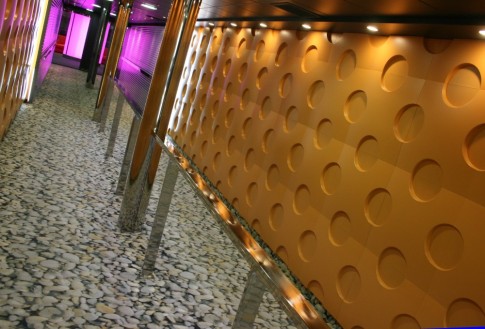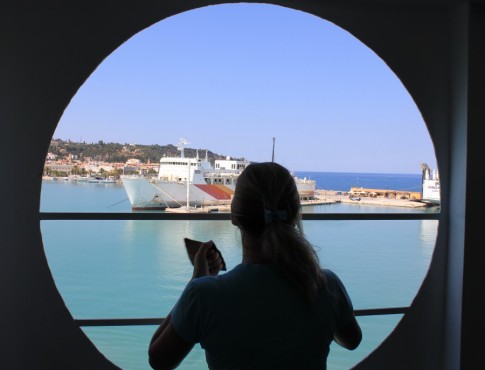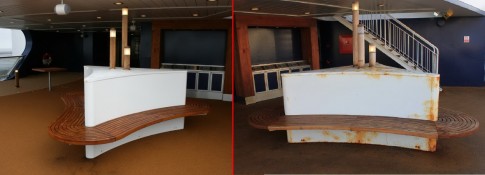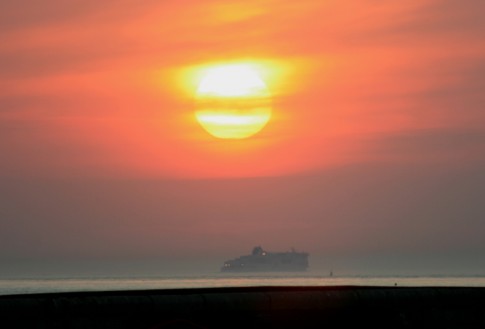If, as I do, you attribute to passenger ferries some of the characteristics of human beings, the cycle of life can be unsettling and, occasionally, brutal. How did those jumbo ferries with which I grew up suddenly become middle-aged? Why are the outside decks of the cutting-edge Norsea caked in years of rust? What calamity has befallen the shiny, new Fiesta that has caused her to go for scrap?
In the times of plenty, old favourites would head south for long and, hopefully, fruitful careers. Today, with the Greek economy in particular in ruins, no home can be found for them there. Instead, the scrap yard beckons all too soon and the production line of replacement new ships has all but dried up. Those which did appear in 2011 often seemed to be more dysfunctional than historic.
The veterans which survive often seem to be clinging on, just one unpaid subsidy away from the end. Happily, if you look in the right hidden corners, more than a few remain, shyly eking out a living at the margins of the ferry industry. 2010 was spent saying farewell to some quite well known, doomed, elderly ships; the ferry year of 2011, perhaps more than ever before, was focussed on the marginal, the half-forgotten, the never-remembered.
Based purely on subjective feelings on the 66 ships sailed on or visited in 2011, here are some of the bests and worsts of the year.

Best new ferry
The well documented difficulties of the Spirit of Britain somewhat preclude her from taking this title and the only other 2011 newbuild sailed upon was the functional but somewhat derivative Stena Transporter. New to me this year, however, were Balearia’s 2010-built Abel Matutes and SF Alhucemas. Like the Martin i Soler two years ago, these Spanish-built ferries capture a suitably stylish sense of adventure with hints of practical luxury. The Abel Matutes is a large ro-pax whilst the ‘Alhucemas’ is more like a smaller version of the Martin i Soler. Although neither is perfect, they represent an appropriately modern vanguard for the Spanish ferry industry in the second decade of this century.

Best conversion
The lack of a particularly vintage crop of new vessels leaves the Stena Superfasts as the most impressive ferries newly sampled this year. Whereas in their previous incarnations the pair were comfortable and pleasant overnight ships the new-found, peculiar genius of Figura has seen them transformed into something quite special. Alongside the new port in Cairnryan they form the centrepiece of a determined attempt to wrest back Stena’s lost dominance on the North Channel – a project which deserves to succeed, if nothing else than for its breathtaking boldness. One does wonder if (or over how long a period) the revamped operation can possibly repay all the investment.
On the down side, see also ‘Worst food’ below.

Worst conversion
I found the work done by Viking Line to the Rosella somewhat underwhelming. The surviving bits of the ship’s original interiors are clearly much smarter than the new – it’s that bit too apparent that the designers were working to a strict budget. The conversion of former cabins on Deck 4 to public toilets by the expediency of removing the bunks and adding a “W.C.” sign outside the en-suite sums this one up.

Best classic ferry
The Maria Maddalena was built in 1955 as the Ærøskøbing for Danish domestic service between her namesake hometown and Svendborg. Sold after just four years, she has spent the past half century in Italian coastal service, and now serves the remote island of Ponza for SNAP. This little ship is a remarkable survivor and, on board, retains more than could be expected of her original outfit, from the wooden planked vehicle deck to the vintage bridge.

Favourite crossing
When boarding the Ionian King for a departure from Brindisi to Corfu, Igoumenitsa and Zante in August the ship was surprisingly busy. Having planned to sleep, in line with Brindisi tradition, beneath the stars we found that we were able to negotiate a quite beneficial ‘cash only’ price for a cabin at the purser’s desk. This turned out to be a quite swish Japanese original, complete with shoji screens and Shin Nihonkai blankets. By the time we finally awoke the following morning, with our intermediate ports of call long behind us, we found the ship virtually and delightfully deserted for the eight hour leg to the so-called party island. Further exploration of this big and beautiful overnight ferry reconfirmed my previous thoughts: that the Ionian King and Ionian Queen were truly the finest ferries on the southern Adriatic. Sadly, within weeks, the ‘King’ had left Europe and returned to Japan for operation as a neo-cruise ship between Shanghai and Nagasaki. This sailing was the perfect way to say goodbye.

The very next sailing after the Ionian King was Tyrogalas’ Ionian Star from Zante to Kyllini. In contrast, this ship was filled to the brim to the degree that many motorists retreated to their cars whilst for many of the rest of us the only ‘seats’ to be found were the stairs leading up from the car decks. An unpleasant experience.

The generally decrepit Seatrade of Ventouris Ferries was probably the most unsettling ferry sailed on this year. However, the disgraceful decline of the outside decks on P&O’s brand new Spirit of Britain between my first sailing in January and most recent in October outdo even the most lackadaisical of Greek operators. Despite the ship’s widely-reported operational problems, there can be few excuses for this lack of basic maintenance.
Special mention should also be made of the small but stinky brown deposit left on the wall by the lavatory of our otherwise clean bathroom aboard Polferries’ Scandinavia. Whoops.

No self service. Just fast food. In a box. Even the menu in the Plus Lounge on the Stena Superfasts has been dumbed down. A big, big shame.
Elsewhere, the Marrakech was predictably dismal whilst both of the ships of St Peter Line struggled badly to produce much edible on the smörgåsbord front.

It might seem unlikely, but the restaurant on board the Stena Lagan conjured up the most memorable ferry meal of the year on a December sailing between Belfast and Birkenhead. Moderately priced and perfectly formed, one can only hope that this hidden treat isn’t brought into line with the rest of the Stena fleet anytime soon. Honourable mentions also to the Scandinavia and to the Pride of Rotterdam.

Biggest disappointment
On a hot July evening we found ourselves one of three parties overnighting on the Bore, now in static use in Turku. The lack of ventilation, musty cabins and more than occasional power cuts made for a memorable, if not particularly comfortable, stay. Much remained to be done but, in the ship’s defence, her owners admitted that one of the reasons it was so difficult to book a stay on board was that they had yet to complete all the work they wanted to before having the full, formal launch.

So. Farewell then.
I have always felt an affinity for Seafrance; for here, Wightlink apart, were the last true inheritors to the Sealink tradition – including the strikes, the sometimes off-hand (or worse) service and even some of the ships. It contradicts received wisdom to call them a success, but on the surface they were: who, following the end of Sealink in 1996, would have imagined it would be Seafrance rather than Stena that, at their peak, would accommodate as much as 45% of Dover-Calais freight.
However, the whole project was built on financial sand and the end has come as violently for the company as it has for the two ships upon which it was founded: just after the Seafrance Renoir and Seafrance Cezanne headed for the beaches of Turkey, Seafrance stopped sailing. I travelled on the ‘Moliere’ days before the end; unlike deadly crossings earlier in the year on the ‘Rodin’ and ‘Berlioz’, here everything was open, the restaurant served decent food and, if you let yourself day dream just a little, maybe there was a future after all. It was not to be.
Unlike Seafrance and their early ships I cannot say I have great memories of the Romilda (ex-Free Enterprise VIII) but I feel I should at least make mention of her demise. She always seemed to appear on the horizon about thirty minutes beyond which queuing in one of the quayside cattle pens stopped being bearable; arrivals were always just after hoteliers and barkeeps had gone to bed; and the ship was always just that fraction more dilapidated than can be endearing. But still, this was a ship with a heart and when both sailed on routes through the western Cyclades, there was the happy opportunity to compare the Romilda to her longstanding rival, through both British and Greek careers, the Agios Georgios (ex-Hengist). Her familiar presence in Piraeus will be missed.



I find your comment on the food department regarding St. Peter Line interesting, as when I was onboard the Princess Maria last February the smorgasbord was quite good. The main corses were a bit of disappointment, but the starters and desserts were very good (and certainly superior to what I had recently eaten on Viking and Silja). Although from what I have undersootd from elsewhere the company product tends to be very uneven in quality in other fields too.
It’s always nice to read your blog and this article is no exemption. But still I feel that the scraping of the Tirrenia’s HSC (Aries, Taurus, Capricorn) is one of THE news of 2011… Those ships were not even 15 years old… True they were petrol guzzlers, but technology wise they were a nice piece of engeneering.
More pictures here: http://www.naviearmatori.net/gallery/viewalbum.php?id=527